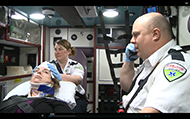ANTHROPOMETRY

Anthropometry is the science that defines physical measures of a person’s size, form, and functional capacities. Applied to occupational injury prevention, anthropometric measurements are used to study the interaction of workers with tasks, tools, machines, vehicles, and personal protective equipment — especially to determine the degree of protection against dangerous exposures, whether chronic or acute.
Why is anthropometry important?
Designs that are incompatible with normal anthropometric measurements of a workforce may result in unwanted incidents.
- The misfit of a heavy equipment cabin to a worker may produce operator blind spots that expose workers on foot to struck-by injuries.
- Inadequate length or configuration of seatbelts may lead to non-use of seatbelts, which affect post-crash survivability.
- Inadequate fit of personal protective equipment cannot provide workers with sufficient protection from health and injury exposures.
Existing data on the size and shape of industrial workers is limited. Because of the lack of anthropometric data for the general worker population, safety researchers have generally relied on data drawn from studies of military personnel, most of which was collected during the 1950s to 1970s. However, substantial anthropometric variability exists among the various U.S. workforce populations, and they are quite different from the average military population. Industrial workers, such as the agriculture, truck driver, and firefighter workforces, are also anthropometrically very different from the average civilian population (Hsiao et al, 2002).
Diverse workforces in many occupations, as well as new roles for women in the workforce, require body-size data for designing adequate workplaces, systems, and personal protective equipment. In the past, variance in body dimensions was typically reported as means and standard deviations for various body segments (Roebuck et al., 1975). This approach was successful in generating broad parameters for personal protective equipment (PPE) sizing but was deficient in generating the detailed fit information needed for workplace, PPE, and other equipment design.
Technological development in recent years has advanced the basic science of human size and shape studies in 3-dimensional forms (3D). Also, computer-generated human models are now available for anthropometric analysis. These advances in anthropometric science and computer-based human-form modeling have opened various research avenues for improving workplace and protective equipment design as well as anthropometric fit within complex systems.
Hsiao, H., Long, D., Snyder, K. (2002). Anthropometric differences among occupational groups. Ergonomics, 45(2), 136-152.
Roebuck, J. A. (1975). Engineering Anthropometry Methods (Wiley Series in Human Factors). John Wiley & Sons Inc.
What are current trends in anthropometric research?
Anthropometric design procedures must take into consideration the large variation in dimensions from person to person and from population to population. In the research area of applied anthropometry, collecting and use of 3D anthropometric data have become a norm, which will ultimately result in a better fit between workers and their tools, systems, and work environments.
 Firefighter Anthropometry Datasets
Firefighter Anthropometry Datasets
U.S. firefighter anthropometric information is needed to update specifications for fire apparatus and firefighter protective equipment.
 Anthropometric Study of U.S. Truck Drivers
Anthropometric Study of U.S. Truck Drivers
NIOSH launched the first-ever federal anthropometric study of U.S. truck drivers.
U.S. EMT anthropometric information is needed to improve the workspace design of ambulance patient compartments for safe and effective performance.
Program contact: Hongwei Hsiao, Ph.D.
Protective Technology Branch
304.285.5910 HHsiao@cdc.gov
- Page last reviewed: April 12, 2017
- Page last updated: December 1, 2016
- Content source:
- National Institute for Occupational Safety and Health Division of Safety Research


 ShareCompartir
ShareCompartir
